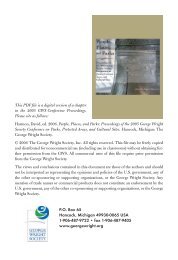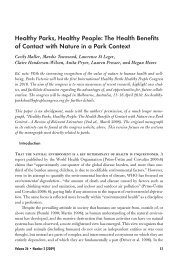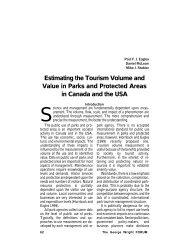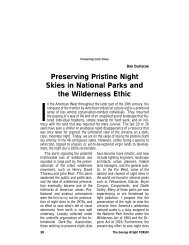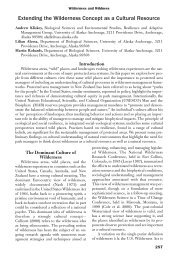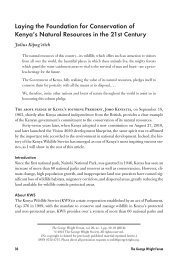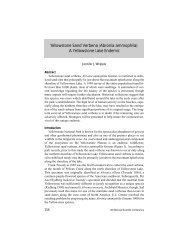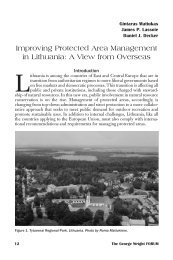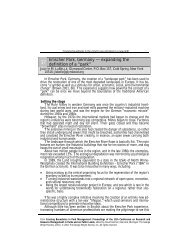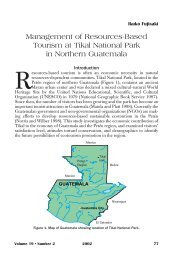Big Egg Marsh Experimental Restoration in Jamaica Bay
Big Egg Marsh Experimental Restoration in Jamaica Bay
Big Egg Marsh Experimental Restoration in Jamaica Bay
Create successful ePaper yourself
Turn your PDF publications into a flip-book with our unique Google optimized e-Paper software.
tussocks of smooth cordgrass (Spart<strong>in</strong>a alterniflora). Prescribed places with<strong>in</strong> the site were<br />
to receive an additional layer of sand up to 23 cm thick, to atta<strong>in</strong> a maximum elevation of 43<br />
cm above the reference plane. The lowest-ly<strong>in</strong>g mudflats and dra<strong>in</strong>ages (which cut below the<br />
reference plane) were, therefore, to receive up to 100 cm of fill. The design was to place most<br />
of the sand <strong>in</strong> an L-shaped ridge, parallel<strong>in</strong>g a bend <strong>in</strong> the adjacent creek. The total volume<br />
of sand needed was estimated at 5,000 to 6,000 cu m. Sand was to be dredged from a trench<br />
along the deepest part of the creek bottom, and sprayed throughout the fill site. The dredg<strong>in</strong>g<br />
and spray<strong>in</strong>g were planned to start <strong>in</strong> summer 2003, immediately after the environmental<br />
compliance was completed.<br />
The f<strong>in</strong>ished fill elevation was designed so that most of the marsh would be covered by<br />
the daily high tide. The highest parts of the filled site are the same elevation as the lower edge<br />
of nearby common reed (Phragmites australis). If the fill were any higher, the treatment<br />
marsh would be at risk of <strong>in</strong>vasion by the unwanted alien genotype of common reed.<br />
Ecological Monitor<strong>in</strong>g<br />
Before beg<strong>in</strong>n<strong>in</strong>g the restoration, one year of ecological monitor<strong>in</strong>g was done. It was<br />
accomplished collaboratively through a cooperative agreement between the National Park<br />
Service (NPS) and the Aquatic Resources and Environmental Assessment Center (AREAC)<br />
at Brooklyn College, City University of New York. Coord<strong>in</strong>ation and carry<strong>in</strong>g out the fieldwork<br />
was done by Gateway natural resources staff, assisted by AREAC student <strong>in</strong>terns and<br />
by volunteers (local and <strong>in</strong>ternational). Technical supervision and support were provided<br />
through the NPS Cooperative Ecosystem Studies Unit at the University of Rhode Island,<br />
and through the NPS Boston Support Office.<br />
Monitor<strong>in</strong>g of the control site and treatment site began <strong>in</strong> autumn 2002, one year before<br />
the sand was applied—thus, we have comparisons of the control and treatment sites both<br />
before and after. Monitor<strong>in</strong>g is focused on physical and chemical changes of the marsh surface<br />
and creek bottom, changes <strong>in</strong> plant cover, and changes <strong>in</strong> animal occurrence. Each site<br />
has three surface elevation tables (SETs), more than 100 grid markers (many with elevations),<br />
and 30 permanent 1-m 2 vegetation plots. Also, on the treatment site there are sixteen<br />
2-m 2 unplanted plots to monitor regrowth of the orig<strong>in</strong>al vegetation and colonization by<br />
seedl<strong>in</strong>gs. There are ten places on each site where the water table is monitored, and where<br />
soil particle size and sulfides are monitored. The occurrence of birds, mammals, <strong>in</strong>sects, and<br />
spiders are surveyed, as are the macro<strong>in</strong>vertebrates <strong>in</strong> the soil and water. Water quality (12<br />
parameters) and fishes are sampled <strong>in</strong> the adjacent creek. Recovery of the excavated trenches<br />
that supplied the sand is be<strong>in</strong>g monitored, too. The monitor<strong>in</strong>g <strong>in</strong> large part follows the<br />
guidel<strong>in</strong>es specific to saltmarshes elsewhere (e.g. Niedowski 2000; Raposa et al. 2001;<br />
Roman et al. 2001).<br />
A SET is <strong>in</strong>stalled at three locations <strong>in</strong> the treatment site and another three <strong>in</strong> the control<br />
site. Each SET consists of a steel rod driven at least 15 m deep <strong>in</strong>to the marsh; the rod<br />
is capped with a movable arm that holds n<strong>in</strong>e sampl<strong>in</strong>g p<strong>in</strong>s (Cahoon et al. 2000). Plots of<br />
either sand or bentonite are placed nearby. The SETs provide <strong>in</strong>formation on subsidence,<br />
upward expansion, erosion, and accretion. Before-and-after and control-and-treatment mon-<br />
The 2005 George Wright Society Conference Proceed<strong>in</strong>gs • 125



